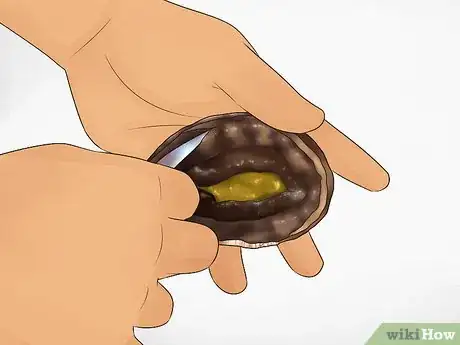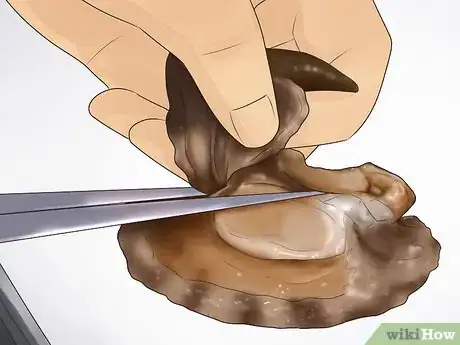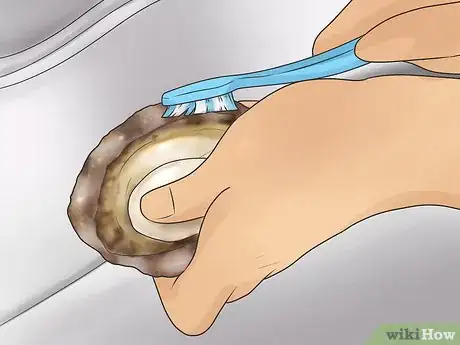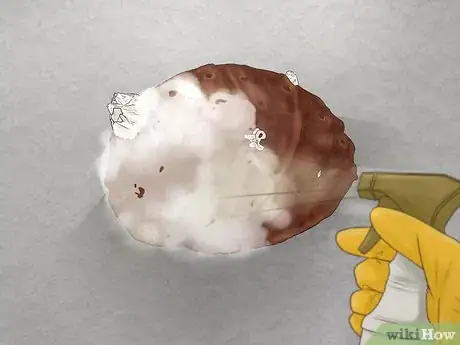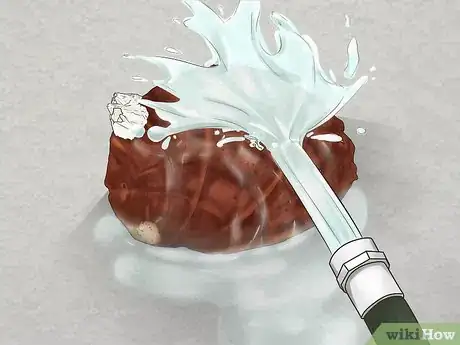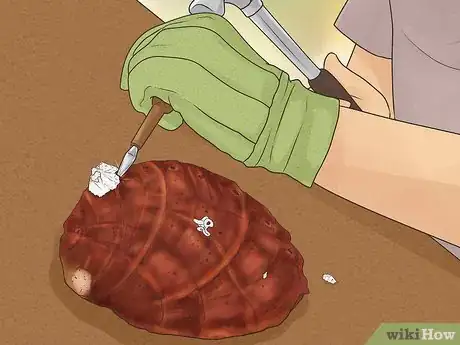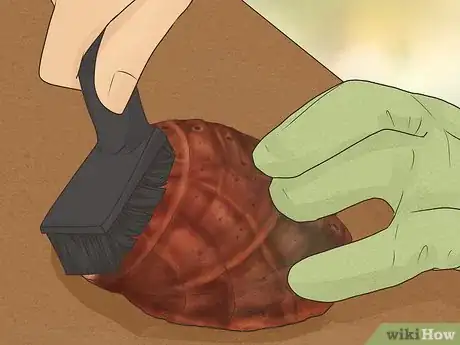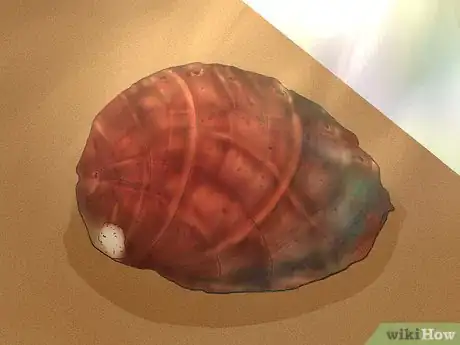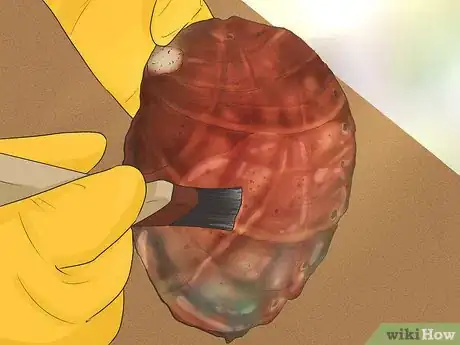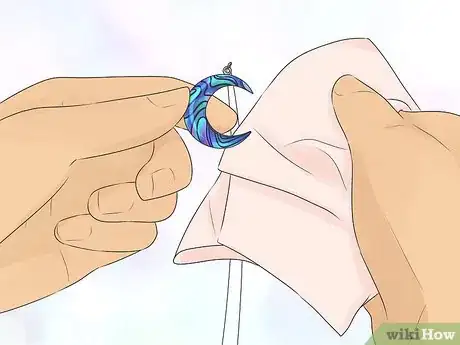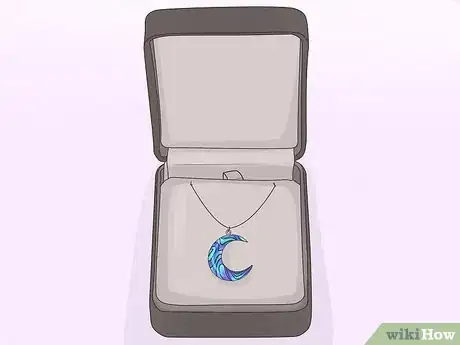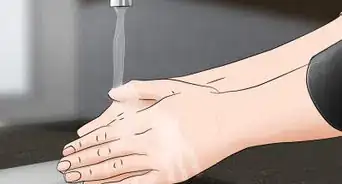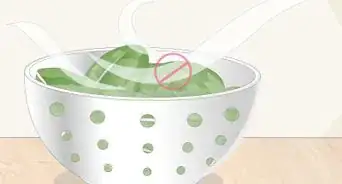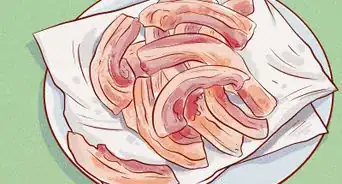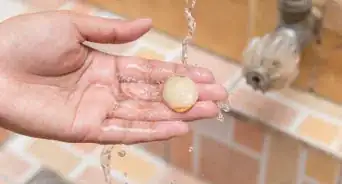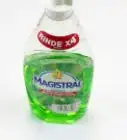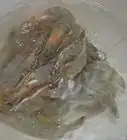This article was co-authored by wikiHow Staff. Our trained team of editors and researchers validate articles for accuracy and comprehensiveness. wikiHow's Content Management Team carefully monitors the work from our editorial staff to ensure that each article is backed by trusted research and meets our high quality standards.
There are 8 references cited in this article, which can be found at the bottom of the page.
This article has been viewed 31,228 times.
Learn more...
Abalone are quick and easy to clean! To clean the meat, simply remove it from the shell, trim off the liver, and remove any dirt from the flesh. If you want to clean the shells, use muriatic acid to help loosen the barnacles and then use a chisel and wire brush to remove them. Polish your abalone jewelry with a jewelry cloth to accentuate their natural colourings and add shine.
Steps
Cleaning Abalone Meat
-
1Scrape the abalone meat out of the shell with an oyster knife. Push the oyster knife under the abalone meat to dislodge it from the shell. If the meat won’t come out, try scraping the meat out from a different angle.[1]
- If you don’t have an oyster knife, use a small serrated knife instead.
- Scrape the meat out of the shells over a sanitised surface in case the meat flies out of the shell unexpectedly.
-
2Trim off the brown liver and guts with a pair of scissors. To the side of the pale abalone meat, you will notice a squishy, dark-brown bag – this is the liver and the guts. Use scissors to cut off all the brown areas from around the abalone. It is best to remove this as it doesn’t have a pleasant taste.[2]
- Wrap the liver and guts in paper before putting in the bin to reduce the smell.
Advertisement -
3Scrub any dirt off the abalone meat with a scrubbing brush. Abalone often have a little sand or dirt on them after they are retrieved from the ocean. Simply agitate any dirt off with a clean brush. Don’t press too hard, as this can pierce the meat.[3]
- A clean toothbrush or nail-brush will also work well for this task.
-
4Rinse the abalone flesh under a tap. Hold the abalone water under cold tap water to rinse off any dirt that you scrubbed off. If necessary, use your hands to push off any residual dirt from the abalone. If you are cleaning lots of abalone, place them into a bowl to rinse them.[4]
- Avoid using hot water, as this can cause the abalone meat to start cooking.
Sanitising and Shining Abalone Shells
-
1Spray the outside of the shell with muriatic acid. This helps to loosen the barnacles from the shell. Place the shell on a concrete surface outside and then spray the acid over the entire shell. You will notice the acid fizz as it reacts with the shell.[5]
- Purchase muriatic acid from a hardware store.
- Work outside on concrete, if possible, or use an acid-resistant container.
- Always be careful when working with strong chemicals, such as muriatic acid. Wear gloves and a respirator and keep the acid away from children and pets.
-
2Rinse the acid off the shell with water. Liberally pour water over the shell to remove all the remnants of acid. If you have a hose nearby, use this to rinse off the water. Alternatively, pour a bucket of water over the shell.[6]
- Wear gumboots to stop acid from touching your feet.
- Keep your gloves on while you are rinsing the shells to avoid getting burnt by the acid.
-
3Chisel off as many barnacles as you can. Place the head of the chisel onto the barnacles and gently tap the handle with a hammer. This will help to dislodge the barnacles away from the shell. Avoid tapping too vigorously, as this can crack the shell.[7]
- If a barnacle won’t come off, try tapping it at different angles.
- If you don’t have a hammer, use mallet instead.
-
4Scrub off any remaining barnacles with a wire brush. Press down firmly on the brush and agitate off any barnacles from the outside of the shell. Keep scrubbing until the all the barnacles are off the shell. This reveals the beautiful colours underneath.[8]
- Purchase a wire brush from a hardware store.
-
5Leave the shells to dry in the sun for 1-2 hours. This helps to remove any bad smells from the shells and makes them easier to polish. Place the shells in a sunny place where they won’t be stepped on by animals or children. A sunny window sill or porch works well.[9]
- If the shells are still wet after a few hours, simply leave them in the sun until they are completely dry. Drying time will vary depending on your climate.
-
6Polish the shells with mineral oil to add shine. Dampen a clean cloth with mineral oil and gently rub it over your abalone shells. This helps to accentuate the colours in the shell and adds a beautiful sheen. Microfibre cloths and cotton cloths both work well for polishing shells.[10]
- If you don’t have any mineral oil, use baby oil instead.
Polishing Abalone Jewelry
-
1Wear the jewellery regularly to coat it in natural oils. Your skin produces natural oil which will transfer onto the abalone. This helps to polish the shell and brings out its deep colours and patterns.
- Avoid wearing the abalone jewelry in the ocean or in the shower, as salt and beauty products can damage the shiny coating on the jewellery.
-
2Clean your abalone jewellery with a cloth each time you wear it. Jewellery cleaning cloths work best for this task, but microfibre cloths will also do the job. Simply rub the cloth back and forth over the abalone shell to polish and clean it.
- Avoid cleaning your abalone shell with chemicals, as this can damage the fragile shell.
- Purchase a jewellery cleaning cloth from a jewellery store.
-
3Store your abalone jewellery out of the sun in a box by itself. Avoid exposing the abalone shell to extensive sunlight, as this can fade its beautiful colours. Keep your abalone jewellery by itself to avoid it from getting scratched.
- If you don’t have a jewellery box, place it in a jewellery bag.
Warnings
- Muriatic acid is a caustic chemical. Wear thick gloves and a respirator when using it as it can harm your skin and lungs.⧼thumbs_response⧽
Things You’ll Need
Cleaning Abalone Meat
- Oyster knife
- Scissors
Sanitising and Shining Abalone Shells
- Chisel
- Hammer
- Muriatic acid
- Water
Polishing Abalone Jewellery
- Cloth
- Jewellery box
References
- ↑ https://youtu.be/tP64zgFrNak?t=21
- ↑ https://youtu.be/tP64zgFrNak?t=98
- ↑ https://youtu.be/LRLBhIInG74?t=219
- ↑ https://youtu.be/LRLBhIInG74?t=264
- ↑ https://youtu.be/_JJ9yMlPmxg?t=25
- ↑ https://youtu.be/_JJ9yMlPmxg?t=31
- ↑ https://youtu.be/_JJ9yMlPmxg?t=58
- ↑ https://www.prettyprudent.com/2013/09/prudent-home/how-to-clean-seashells/
- ↑ https://www.prettyprudent.com/2013/09/prudent-home/how-to-clean-seashells/
